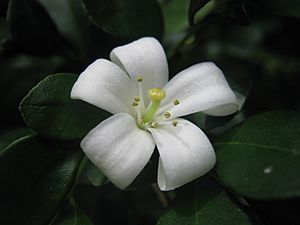Orange jasmine facts for kids
Quick facts for kids Orange jasmine |
|
|---|---|
 |
|
| Foliage and flowers | |
| Scientific classification | |
| Genus: |
Murraya
|
| Species: |
paniculata
|
| Synonyms | |
|
|
The orange jasmine (scientific name: Murraya paniculata) is a type of shrub or small tree. It is also known as orange jessamine, china box, or mock orange. This plant belongs to the Rutaceae family, which also includes citrus fruits. It originally comes from places like South Asia, Southeast Asia, and Australia.
Orange jasmine has smooth bark and leaves made up of smaller leaflets. Its flowers are white or cream-colored and smell very sweet. After flowering, it grows small, oval, orange-red berries. These berries contain tiny, hairy seeds.
Contents
What the Orange Jasmine Looks Like
The orange jasmine tree can grow up to about 7 meters (23 feet) tall. However, it often starts to flower and produce fruit when it is still a smaller shrub. Its bark is smooth and can be pale or whitish.
The leaves are special because they are pinnate. This means they have several smaller leaflets arranged along a central stem, like a feather. Each leaf can be up to 170 mm (6.7 inches) long. They usually have up to seven glossy green leaflets. These leaflets are smooth (glabrous) and can be egg-shaped or oval. They are typically 25–100 mm (1–4 inches) long and 12–50 mm (0.5–2 inches) wide.
The flowers are very fragrant. They grow in loose groups, with each flower on a short stalk (pedicel). Each flower has five (sometimes four) small green parts called sepals at its base. It also has five (sometimes four) white or cream-colored petals that are about 13–18 mm (0.5–0.7 inches) long.
In Australia, orange jasmine flowers from June to March. After the flowers, the plant produces oval, smooth, orange-red berries. These berries are about 12–14 mm (0.5 inches) long and contain seeds covered in fine hairs.
How Orange Jasmine Got Its Name
The orange jasmine was first officially described in 1767 by a famous scientist named Carl Linnaeus. He gave it the name Chalcas paniculata.
Later, in 1820, another botanist named William Jack changed its name. He renamed it Murraya paniculata in his book about plants from Malaysia.
Where Orange Jasmine Grows
Orange jasmine naturally grows in rainforests. It often grows as a smaller shrub under taller trees. You can find it behind beaches in some areas.
It is native to many parts of the world. This includes South and Southeast Asia, China, and Australasia. Its natural range stretches from Pakistan, India, and Sri Lanka, all the way to southern China, Taiwan, the Philippines, and even some Pacific islands like the Ryūkyū and Mariana Islands. It also grows south through Malaysia and Indonesia to New Guinea and parts of Australia.
In Australia, it is native to the Kimberley region of Western Australia. It also grows in the northern parts of the Northern Territory and some areas of Queensland.
Sometimes, orange jasmine has been planted in new places by people. In some of these areas, it has become a naturalized plant. This means it grows well on its own, even without human help. In some cases, it can even become an invasive weed. This means it spreads quickly and can take over areas, pushing out native plants. For example, a specific type of cultivated orange jasmine is considered a top invasive plant in southeast Queensland, Australia.
Uses of Orange Jasmine
People often grow orange jasmine as an ornamental tree or a hedge. This is because it is a very tough plant. It can grow well in many different types of soil, including sandy, clay, acidic, or alkaline soils. It's a great choice for creating larger hedges.
The plant flowers throughout the year, producing small, sweet-smelling flower clusters. These flowers attract bees, which help with pollination. The fruits are also popular with small birds that eat fruit (frugivorous birds).
Reproduction and Growing New Plants
Orange jasmine can reproduce in two main ways:
- By seeds: Birds often eat the fruits of the orange jasmine. When they do, they later spread the seeds in their droppings. This helps new plants grow in different places.
- By cuttings: People can also grow new orange jasmine plants from "softwood cuttings." This means taking a small piece of a young branch and planting it. This method creates a new plant that is exactly like the parent plant.
Common Plant Problems
Like many plants, orange jasmine can face some problems:
- Pests: It can be affected by tiny worms in the soil called nematodes. It can also get small insects like scales and whiteflies on its leaves.
- Diseases: Sometimes, a black, powdery substance called sooty mold can grow on the leaves. This mold is usually caused by sticky liquid left behind by insects.
Orange jasmine is also a favorite plant for an insect called the citrus psyllid. This tiny insect is a big problem because it can carry a serious plant disease called citrus greening disease. This disease can harm citrus trees, making their leaves yellow and their fruits small and bitter.
Gallery
See also
 In Spanish: Murraya paniculata para niños
In Spanish: Murraya paniculata para niños







